Physical Address
304 North Cardinal St.
Dorchester Center, MA 02124
Physical Address
304 North Cardinal St.
Dorchester Center, MA 02124

Investigate whether RV slide-out awnings are a smart investment or an unnecessary expense for protecting your recreational vehicle's longevity.
If you’re debating whether to invest in RV slide-out awnings, you’re not alone. While these protective coverings aren’t mandatory for your RV’s operation, they can markedly impact your vehicle’s longevity and maintenance costs. As an essential shield against nature’s elements, they offer more than just basic protection – but is the investment worth it for your specific situation? Let’s explore the real benefits and drawbacks to help you make an informed decision.
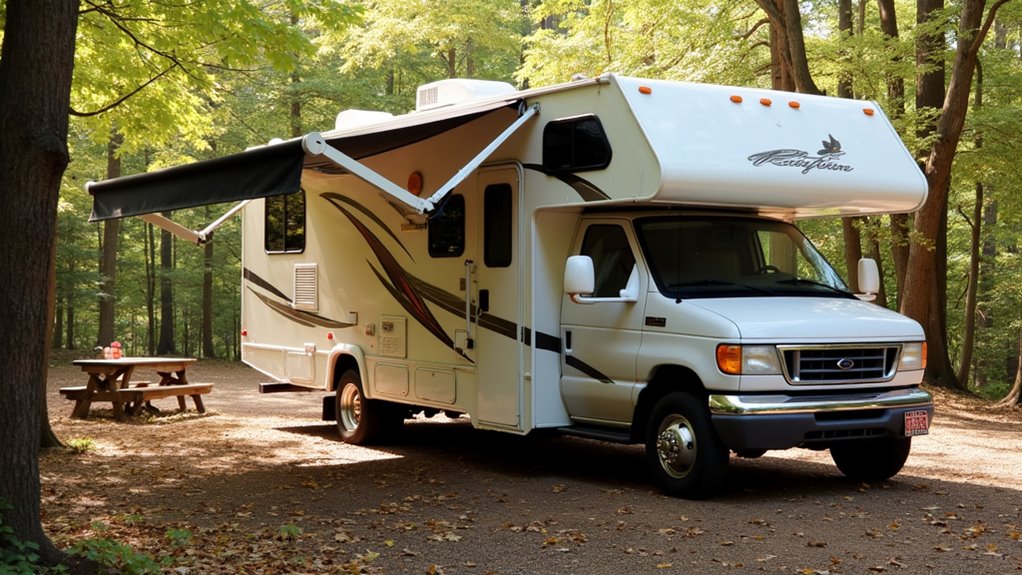
While RV slide-out awnings may seem like a simple accessory, they’re essential protective covers that shield your RV’s slide-out sections from the elements.
These slide toppers automatically extend and retract with your slide-out, creating a protective barrier against rain, snow, leaves, and debris. Some RVers find proper maintenance essential when it comes to ensuring their slide toppers remain effective and durable over time.
You’ll find that slide-out awnings serve multiple purposes beyond basic protection. They prevent debris accumulation on your slide roof, which helps avoid mechanical issues and reduces maintenance needs.
When installed, they act as an additional layer of insulation, helping regulate your RV’s interior temperature. They’re particularly effective at protecting against UV rays that can degrade seals and roof materials over time.
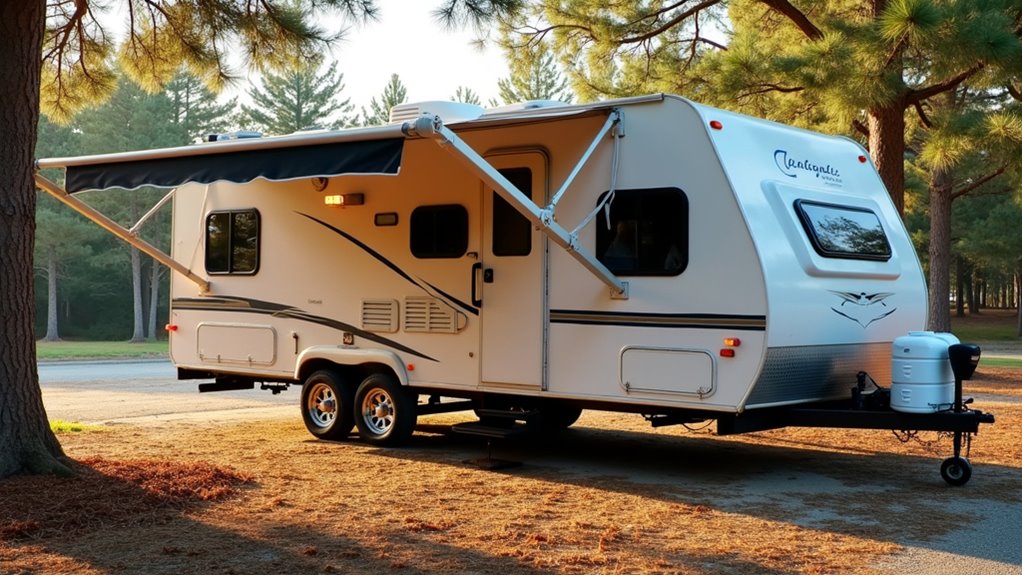
Installing slide-out awnings on your RV delivers five essential benefits that protect your investment and enhance your camping experience.
You’ll get superior protection against water damage as the awnings divert rain and melting snow away from your slide-out seals and prevent pooling in corners. A properly measured awning should extend 2.5 inches per side beyond the slide for optimal coverage.
They also block debris like leaves and branches from collecting on top, which could otherwise damage seals or cause mechanical issues during retraction.
Your slide-out roof will last longer with reduced UV exposure and heat buildup. Just like continuous AC operation in your RV, proper protection helps maintain comfortable interior temperatures.
Protect your RV investment with slide-out awnings – they shield against damaging UV rays and prevent excessive heat accumulation on your roof.
You’ll enjoy better interior comfort through additional shade and improved insulation, potentially lowering your HVAC costs.
Most importantly, you’ll prevent costly mechanical problems by keeping debris away from motors and moving parts, ensuring smooth operation of your slide-out mechanism over time.
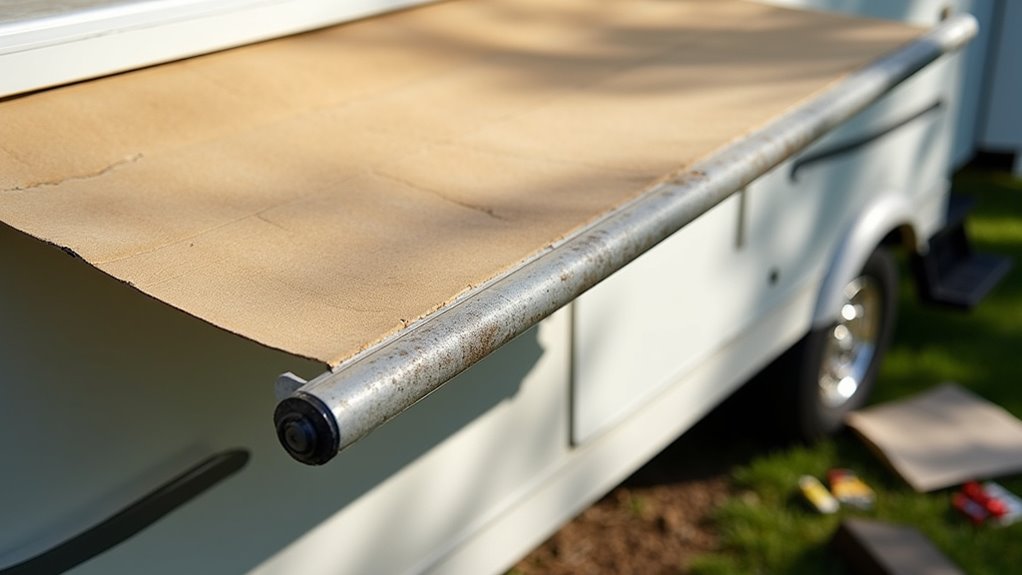
Before committing to slide-out awnings, you’ll need to understand the full financial picture. Installation costs range from $500 to $1,500, with the topper itself costing $300-$400. Labor can add another $900, especially if you choose dealer installation over a local technician.
Many skilled RV owners complete their DIY installation in 2-hours with a friend’s help. You’ll face ongoing maintenance expenses too. Fabric replacement runs $300-$400, and you’ll need periodic seam resealing.
While these costs might seem steep, they’re minimal compared to repairing water damage or replacing a slide-out motor. DIY installation can reduce initial costs but may void warranties and requires technical skill.
Consider the long-term value: slide-out toppers protect your investment, increase resale value, and prevent costly repairs. Some owners offset costs by renting their RVs during off-seasons to cover maintenance expenses.
When properly maintained, they’ll serve you reliably for years, making them a smart financial decision for most RV owners.
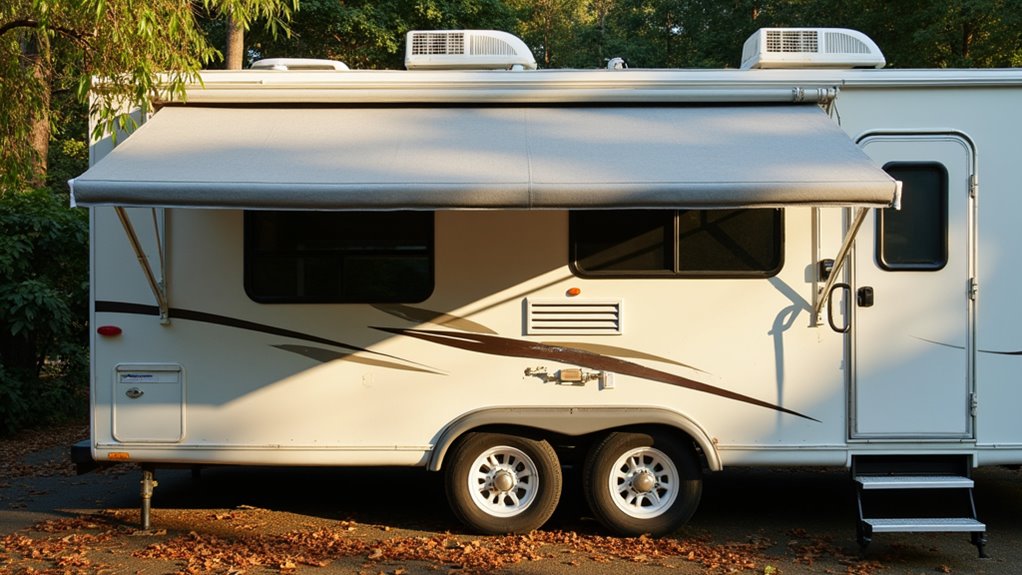
When it comes to protecting your RV investment, slide-out awnings deliver extensive defense against nature’s harshest elements.
You’ll get thorough protection from UV rays, rain, snow, and debris that could otherwise damage your slide-out materials and seals. The leak-proof seams provide additional protection against water intrusion during heavy rainfall.
Most modern awnings are built with durability in mind, featuring heavy-duty vinyl or fabric materials that can withstand extreme temperatures down to -25 degrees Fahrenheit.
Today’s RV awnings combine rugged vinyl and fabric construction with impressive cold-weather performance, standing strong even in sub-zero temperatures.
You’ll find corrosion-resistant frames made from aluminum or stainless steel, ensuring long-term reliability.
The automatic extension and retraction systems work seamlessly with your slide-out’s movement, making operation effortless while reducing maintenance needs.
Whether you’re dealing with scorching sun or heavy rain, these awnings help maintain your RV’s seals and protect its interior from temperature fluctuations, ultimately extending your vehicle’s lifespan.
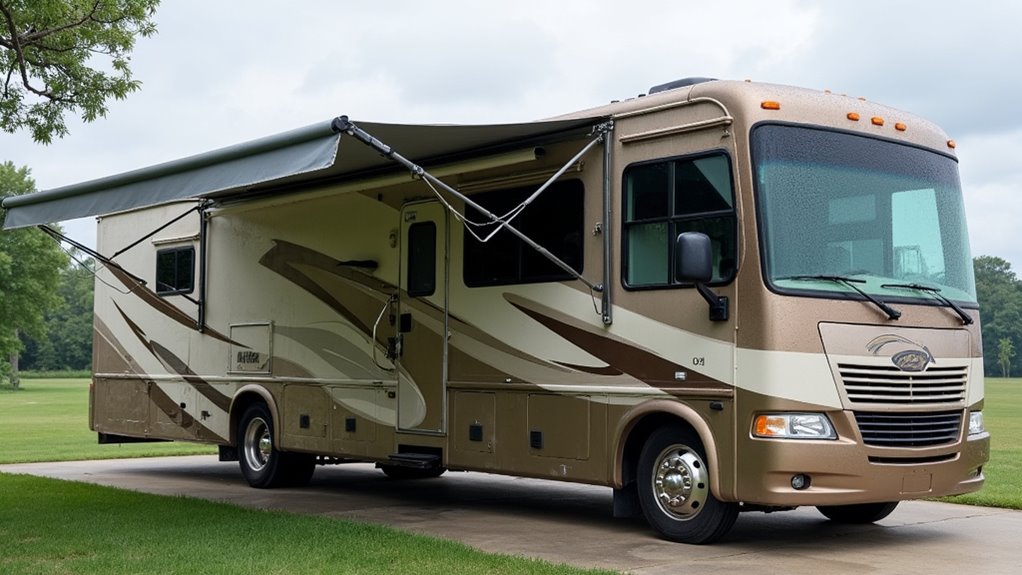
Despite proper maintenance, RV slide-out awnings face several common challenges that require timely attention and solutions.
You’ll encounter fabric wear from UV exposure and debris, which accelerates aging and can prevent smooth operation. Regular cleaning with RV awning cleaners helps extend fabric life and maintain functionality.
Spring tension issues often lead to sagging or poor retraction, while mechanical problems with latches or cranks can disable the entire system.
Water management presents another significant challenge. If you don’t retract your awning during rain, you’ll risk water pooling, mildew growth, and fabric degradation.
Installation complications can also arise, particularly during DIY attempts. When facing these issues, you’ll need to follow manufacturer guidelines carefully.
For major repairs or replacements, it’s best to seek professional help, as improper handling can cause permanent damage to both the awning and your RV’s structure.
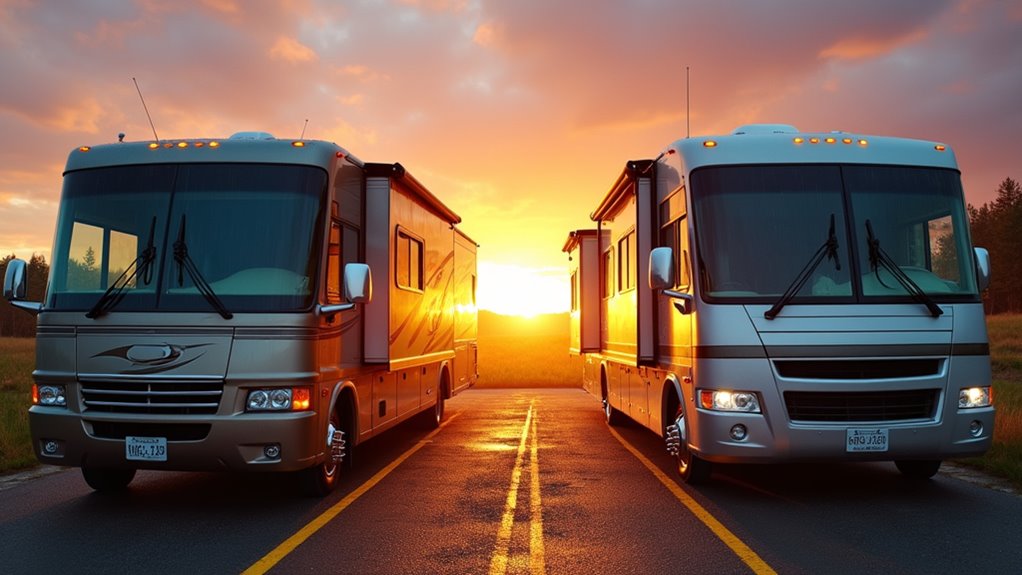
Making a smart investment in RV slide-out awnings requires careful evaluation of both immediate costs and long-term benefits.
While you’ll spend $300-400 on a replacement fabric, this cost is minimal compared to potential slide-out repairs from water damage or debris accumulation. With a lifespan of 5-8 years, you’re looking at excellent value for your investment.
Consider that these awnings reduce maintenance frequency and protect against costly structural damage. The awnings serve as a crucial barrier against UV ray damage and harsh weather elements.
Your decision should factor in usage patterns and climate conditions. If you’re frequently camping in areas with heavy foliage or rainfall, slide-out awnings become essential rather than optional.
They’ll protect your slide mechanism, improve insulation, and maintain your RV’s resale value. Given the 12-20% annual replacement rate, it’s clear that many RV owners find these awnings worth the investment.
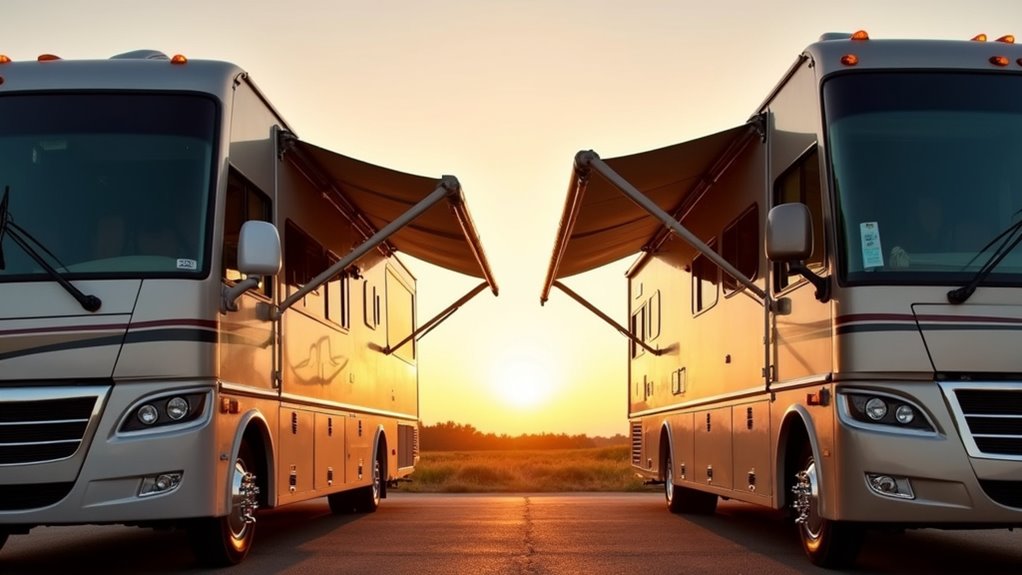
Understanding the long-term value of RV slide-out awnings goes beyond the initial investment calculations. When you assess their worth, consider how they protect your slide-out roof from weather damage, reduce maintenance costs, and potentially extend your RV’s lifespan.
Smart RV owners look beyond upfront costs to see how slide-out awnings protect their investment and reduce long-term maintenance expenses.
While traditional slide toppers require regular upkeep, newer solutions like the True Topper offer maintenance-free alternatives with lifetime warranties. Traditional slide toppers are prone to tearing and sagging over time, which can lead to costly repairs and replacements.
Factor in these long-term benefits against initial costs to determine if slide-out awnings align with your RV investment strategy.

When deciding between professional and DIY installation of RV slide-out awnings, you’ll need to weigh several critical factors that impact both short-term costs and long-term performance.
Professional installation offers expertise, warranty coverage, and ideal fit, ensuring your awning is properly secured and functions safely. You’ll benefit from quick, efficient installation and peace of mind knowing it meets safety standards. However, you’ll pay more for these advantages.
DIY installation can save you money and offers flexibility in timing and customization. While you’ll gain valuable experience, be aware that mistakes could lead to improper fit or damage. Without professional expertise, you might face challenges with weather sealing and weight distribution. Both white and black options are available for matching your RV’s exterior aesthetics.
Consider your skill level, budget, and time constraints carefully.
Remember that professional installation typically provides better durability and warranty support, while DIY requires more research and careful planning.
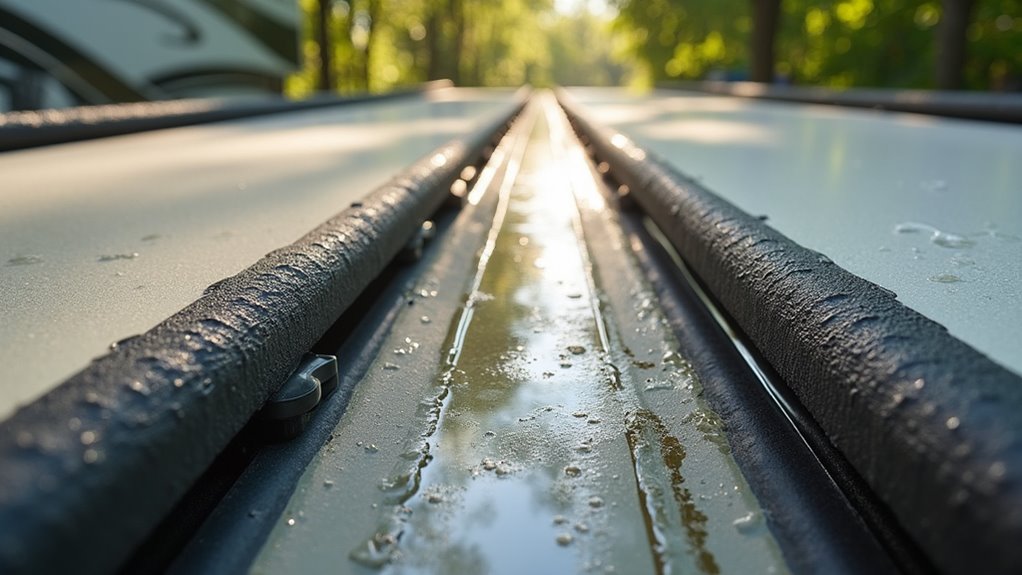
Several cost-effective alternatives to traditional RV slide-out awnings can protect your investment while addressing common issues like wind flapping and water pooling.
You’ll find simple DIY solutions using everyday items that can greatly improve your slide-out’s protection and reduce maintenance costs.
The innovative True Topper mechanism eliminates the need for fabric entirely while effectively removing debris and water from your slide-out roof.
These alternatives can save you hundreds in replacement costs compared to traditional slide-out awnings, which typically run $300-$400 for fabric replacement alone.
Regular maintenance and proper material selection remain essential for long-term protection.
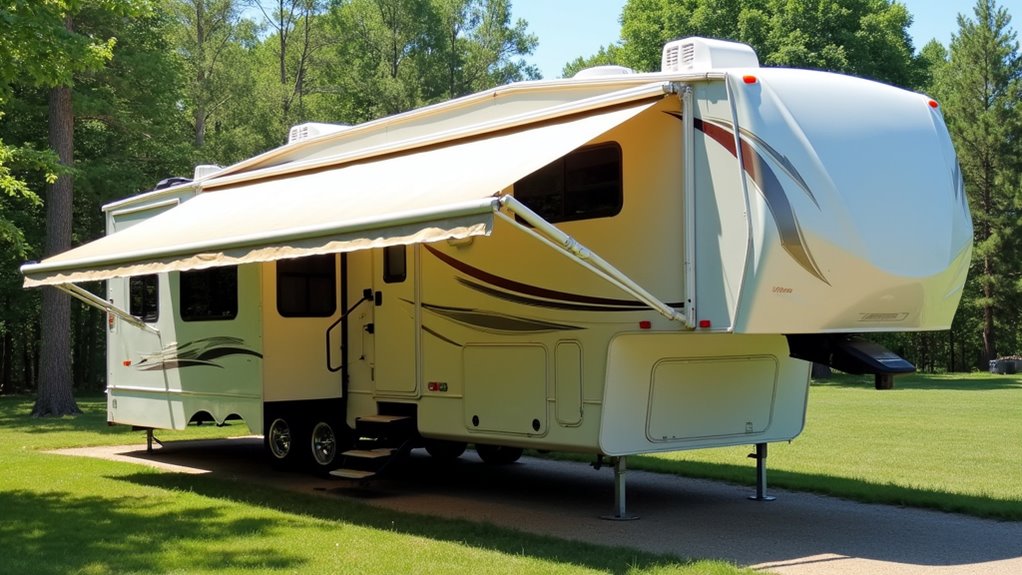
Moving beyond simple alternatives, proper maintenance and usage of RV slide-out awnings can dramatically extend their lifespan and effectiveness.
You’ll need to inspect your awnings seasonally for tears and loose hardware, ensuring proper tension to prevent water pooling. Don’t wait to replace damaged fabric – it’s cheaper than dealing with extensive water damage later.
Many RV owners value slide-out awnings for their ability to provide heat load reduction on their air conditioning systems.
Keep the awnings clean and free of debris, especially before retracting your slide-out.
If you’re camping in extreme weather conditions, you’ll want to monitor your awnings more closely. Plan to replace the fabric every 5-7 years, which typically costs $300-400.
For winter camping, check that your awnings can handle snow loads. If you’re consistently experiencing issues with your awnings, particularly in harsh climates, consider removing them altogether.
You’ll find slide-out awnings aren’t mandatory, but they’re smart investments for your RV’s longevity. You’re protecting against weather damage, preventing mechanical issues, and extending your RV’s lifespan. You’re also boosting resale value and reducing maintenance costs in the long run. Whether you choose professional installation or DIY methods, you’ll benefit from the added protection. Consider your climate, budget, and usage patterns to make the right choice for your needs.